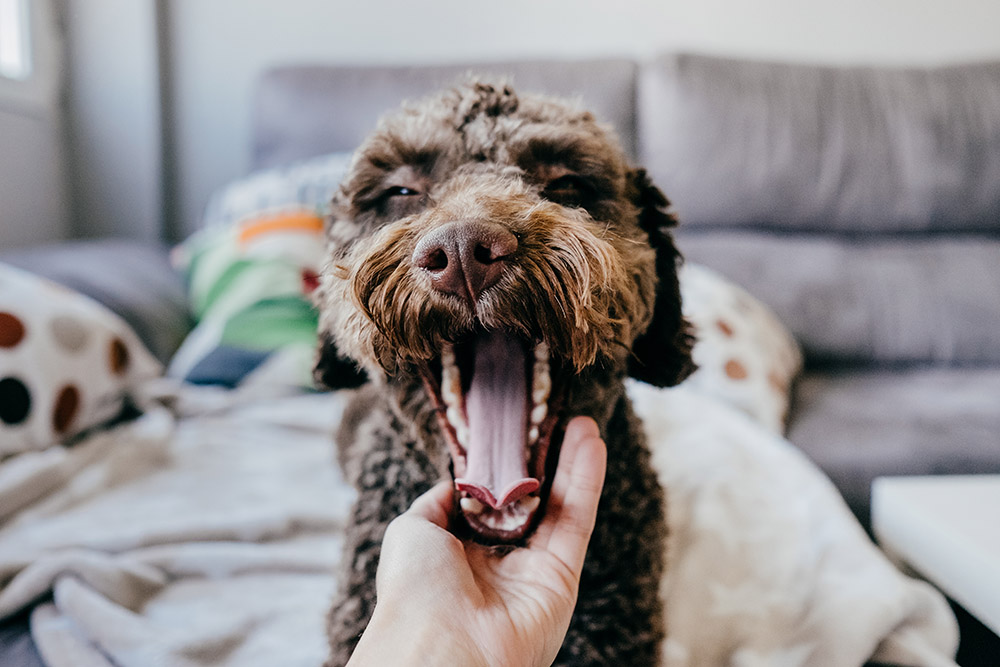
Yawning certainly isn’t something out of the ordinary if you have a dog. However, you may wonder why it seems to occur more often when you pet them. What purpose or, more correctly, purposes does yawning serve? Therein lies the answer to this question.
Think of the many situations where you may yawn. It’s both a voluntary and involuntary act. Scientists know it happens across species and animal class lines, making it multifunctional. So, let’s get into some of the most likely reasons your dog yawns when you pet them.
The 5 Likely Reasons Dogs Yawn When You Pet Them
1. Your Dog Is Tired
Let’s begin with the obvious answer for why your dog is yawning when you pet them. Your dog could simply be tired, and the response might have nothing to do with your actions but the animal’s internal state. Scientists have theorized that yawning increases intracranial circulation, thereby readying your dog for quality time with you.1 It can facilitate the transition from a restful state to an attentive one.
It occurs with the enhanced flow of cerebrospinal fluid in the brain. Intracranial circulation can also modulate levels of an inhibitory neurotransmitter called adenosine. This chemical rises during the course of the day to eventually promote sleep. If your pup was sleepy when you started petting them, they may yawn instinctively to rouse themselves.
Image Credit: RogerMayhem, Pixabay
2. They’re Excited
In the same context, your dog may yawn when they’re excited to increase intracranial circulation for a similar reason. Remember that the research points to it being multifunctional. As the excitement ramps up, so too may the degree and frequency of yawning. Other factors may influence it, including your pet’s internal state, the context, and even the ambient environment.
Another function of yawning is the regulation of the animal’s brain temperature. Research on humans has shown that reflexive or contagious yawning decreased when participants held a cold pack to their foreheads while watching a video of people yawning.2 This phenomenon is well-documented in humans, but not so much in dogs, so we can’t know for sure
3. Stress
The spike in intracranial circulation may also serve a calming function. A dog yawning when petted may be trying to settle itself down with this instinctive act. Research has demonstrated a correlation between arousal levels and yawning. It is quantifiable by increases in cortisol, the so-called stress hormone. The same study identified yawning as a response to moderate stress in social settings.3
The context is significant when you apply this information to petting. Your dog will welcome your attention with responses that are non-indicative of stress. A fearful pup may react differently to a stranger or an overly affectionate child. In these cases, yawning may signal a stressed animal perhaps trying to calm itself.
Image Credit: Fayzulin Serg, Shutterstock
4. It’s a Neurophysiological Response
The biological reasons behind yawning underscore the fact that it may or may not have anything to do with petting your dog. The animal is simply responding to the circumstances. Yawning also serves to maintain homeostasis or a state of internal stability. It’s a vital way an organism ensures reproductive success and survival.
Remember that dogs still have what we may call primitive instincts. They may act seemingly inappropriately in a modern context, but they also haven’t had much pressure to change some behaviors. Yawning can be one way your dog is trying to maintain the status quo to conserve resources.
5. Yawning Is Canine Body Language
Some research suggests that yawning serves social functions, specifically with empathy. These questions are fiercely debated, with evidence supporting both hypotheses. However, an underlying social element may exist. One study considered the yawning contagion and mimicry between dog-dog, wolf-wolf, and dog-human pairings. Their findings support emotional sharing in these interactions.
Yawning can convey any of the emotions we’ve discussed, including ways to avoid conflict. A dog may be signaling that they are friendly. We must stress the context and its implications in interpreting this behavior. After all, it could also be coincidental.
Image Credit: Javier Brosch, Shutterstock
The How and Why of Canine Yawning
Canine yawning opens two exciting avenues of research. We’ve discussed the concept of yawning contagion. One animal does it, and another observing it does the same thing. You’ve undoubtedly experienced it yourself when a family member yawns, and you respond in kind. It may even occur with people you don’t know.
One study documented this behavior between dogs and humans. Surprisingly, the animals detected the difference between yawning and a similar gesture used as a control. It provides further evidence that our canine companions can recognize our emotions. Interacting with your pet is certainly a positive experience. You may even encourage it by how you talk to your pup.
A team of researchers took this body of evidence to the next level to test the neurophysiological basis for yawning between dogs of different sizes. They hypothesized that a larger animal would have a corresponding longer yawn to support the variations in intracranial circulation based on the brain size. The data also suggest biology trumps the purported social functions.
Conclusion
Yawning is such a simple act that we may not consider its other implications. Yes, it serves physical functions to maintain homeostasis. However, it can also relieve stress, possibly communicate emotions, and prepare a pet for social interactions with their owner. All these reasons help explain why your pooch might yawn when you pet them. This body language may have helped forge our bond with our dogs.
Featured Image Credit: Lucia Romero, Shutterstock






